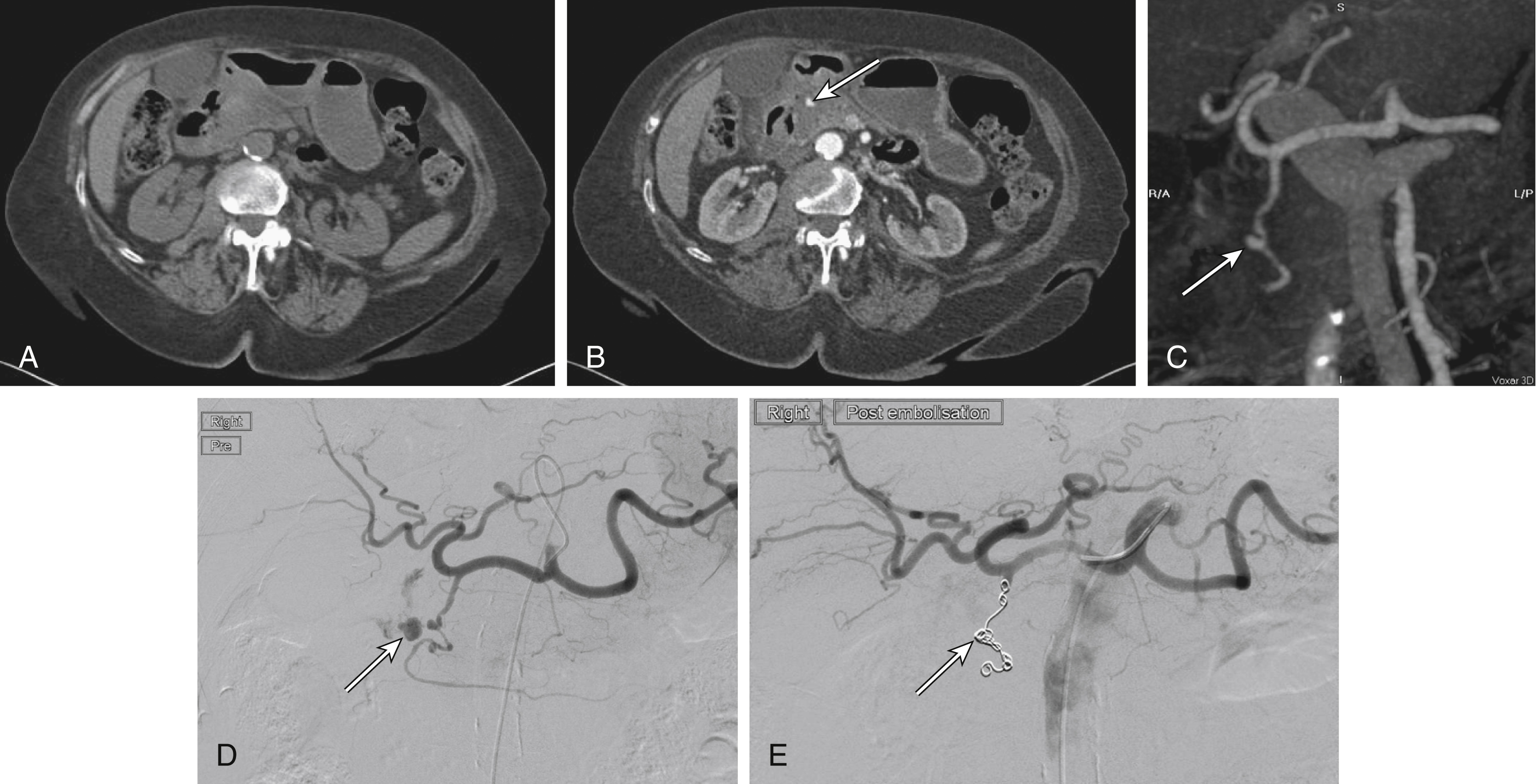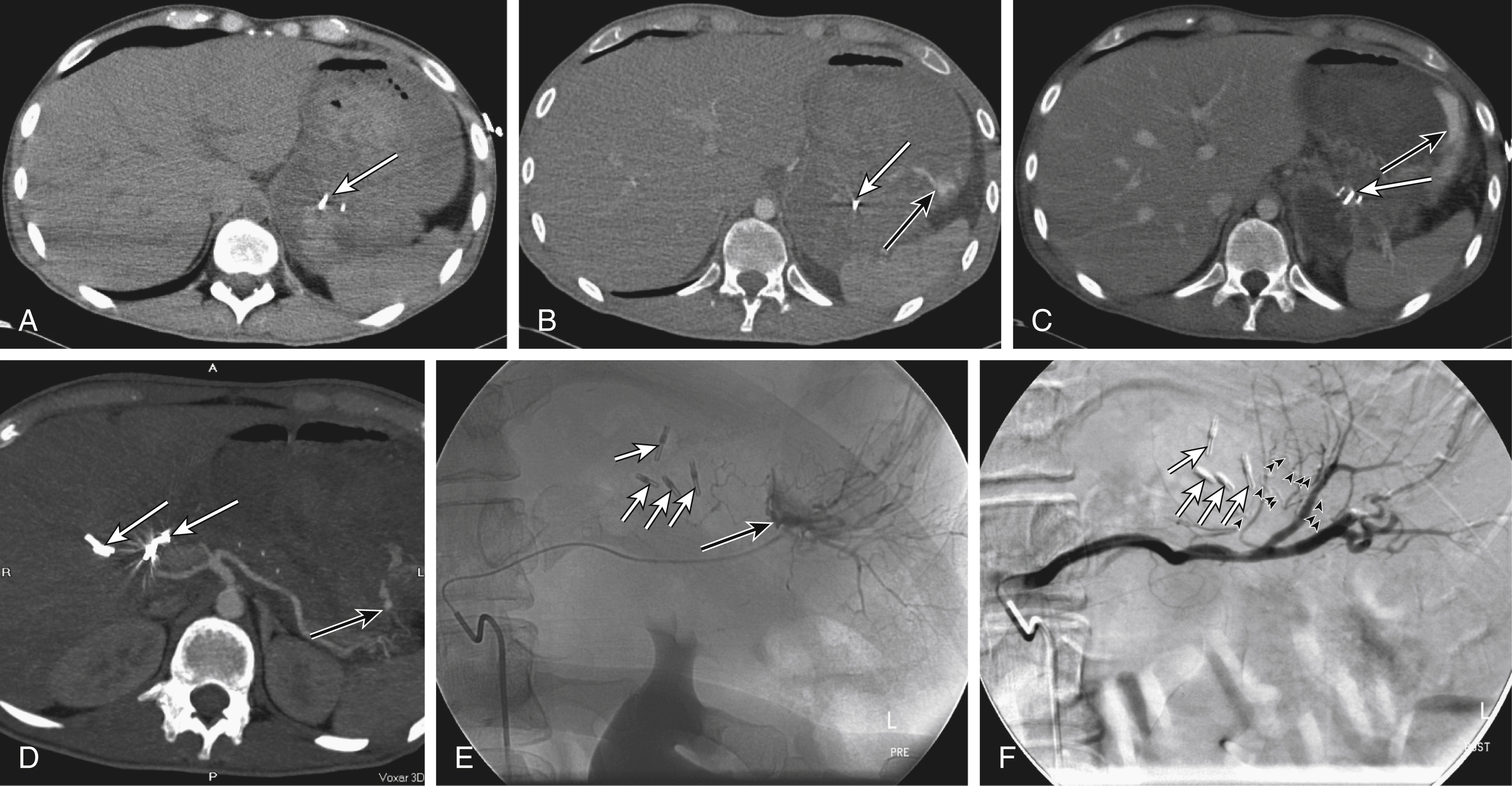Physical Address
304 North Cardinal St.
Dorchester Center, MA 02124
Upper gastrointestinal (UGI) hemorrhage (UGIH) is a common medical problem, with 50,000–70,000 hospital admissions per year in the United Kingdom (UK). It is the second most common medical reason for transfusion after hematological conditions, accounting for 14% of all blood transfusions. Mortality is between 5% and 14% in the UK and North America. Around 15% of UGI bleeds occur in patients who are already in hospital; these cases are associated with a higher mortality rate (26%).
The diagnosis and treatment of UGIH can be challenging due to the intermittent nature of bleeding and the wide range of potential pathologies. Moreover, occurrence in patients with multiple comorbidities can restrict the diagnostic and therapeutic options.
This chapter deals with transcatheter arterial embolization for acute, nonvariceal UGIH; this is the first-line treatment for cases refractory to endoscopic hemostasis. Variceal hemorrhage and lower gastrointestinal hemorrhage are considered in separate chapters.
GI hemorrhage can be classified in several different ways considering the anatomical location of the source, the severity of bleeding, and the results of endoscopy. The anatomical landmark traditionally used to classify the source of GI bleeding is the ligament of Treitz. UGIH originates proximal to the ligament and lower GI bleeding distal to it.
The clinical presentation may offer an indication regarding the anatomical location of the source: UGIH usually causes hematemesis and/or melena, whereas significant lower tract hemorrhages tend to cause hematochezia (bright red rectal bleeding) or altered blood per rectum. However, the clinical presentation can be misleading: the cathartic and properistaltic properties of intraluminal blood may cause hematochezia in a patient who is bleeding massively from the upper GI tract. Occasionally large volume lower GI bleeding can reflux and present with hematemesis. The most common cause of nonvariceal UGIH is peptic ulcer disease. According to population-based studies, this accounts for 50% of all cases. Table 26.1 summarizes the common causes of nonvariceal UGIH.
| Direct Hemorrhage | Transpapillary Hemorrhage |
|---|---|
| Peptic ulceration (gastric and duodenal) Mallory-Weiss tear Gastritis/esophagitis Angiodysplasia Dieulafoy lesion Postanastomotic (marginal) ulcer Arterioenteric fistula (aneurysms and pseudoaneurysms) Tumors (particularly large primary leiomyosarcomas and pancreatic neuroendocrine tumors) Duodenal diverticular disease |
Endoscopic sphincterotomy Hemobilia (trauma, hepatic abscesses, hepatic surgery, liver biopsy, biliary drainage procedures, tumors) Transpancreatic duct (postpancreatitic pseudoaneurysms, tumors) |
Endoscopy allows rapid identification of the site of hemorrhage. UGIH can be further sub-categorized anatomically as direct hemorrhage into the gut or transpapillary hemorrhage. Direct hemorrhage can be due to primary gut pathology or variceal hemorrhage. Transpapillary hemorrhage results from pathology causing hemobilia and/or pancreatic duct hemorrhage, such as iatrogenic trauma and biliary tract neoplasms.
Overt versus occult bleeding is another way to classify GI bleeding—overt bleeding refers to symptoms of visually apparent bleeding, such as hematemesis, melena, or hematochezia.
Occult or chronic GI bleeding is due to a slower rate of hemorrhage. It can present as hemoccult-positive stools with or without iron deficiency anemia. The American Gastroenterological Association defines occult GI bleeding as the initial presentation of a positive fecal occult blood test result and/or iron deficiency anemia when there is no evidence of visible blood loss to the patient or clinician.
Obscure GI bleeding refers to recurrent or persistent bleeding in which a source is not identified after upper endoscopy and colonoscopy. Obscure bleeding may be either overt or occult.
Scoring systems have been developed to assist with the risk stratification of UGIH and to guide management. These include the Glasgow Blatchford Score and the Rockall Score. The Glasgow Blatchford Score is a formal risk assessment tool for UGIH. It uses parameters such as the patient’s blood results, blood pressure, clinical history, and presentation to identify those who require endoscopic evaluation—the first-line investigation in UGIH. The Rockall Score was designed to predict the risk of death based on pre- and postendoscopic findings.
Radiological imaging has become pivotal in the evaluation and treatment of GI hemorrhage when endoscopy fails to control bleeding or is inconclusive. Catheter angiography has both diagnostic and therapeutic roles and is the subject of the bulk of this chapter. In the rest of this section, the role of noninvasive imaging techniques is briefly discussed.
The development of multidetector computed tomographic angiography (MD-CTA) has provided a modality for noninvasive, accurate, sensitive, and rapid diagnosis of hemorrhage in a wide spectrum of clinical scenarios. High-speed and narrow collimation allow coverage of large volumes that include the entire abdomen and pelvis in a single breath-hold; thereby producing images with reduced respiratory and motion artifact. Acquisition can be accurately timed to obtain images during arterial and portal venous phases.
An in vitro study found the threshold for detecting bleeding with MD-CTA to be as low as 0.35 mL/min. According to a recent metaanalysis, the overall sensitivity and specificity of CT angiography for detecting acute GI bleeding were 85.2% and 92.1%, respectively. Preexisting high-attenuation material within the bowel lumen can limit the diagnostic value of the study: a scan prior to intravenous contrast will identify confounders of bleeding.
MD-CTA has several advantages; it is rapidly and widely available and easy to perform. Even when active bleeding is not seen, it may demonstrate the bleeding site owing to high-attenuation thrombus, pseudoaneurysm formation, vessel irregularity or truncation, and possible arterioenteric fistulas. Review of multiplanar reformats aids identification of these abnormalities. MD-CTA can also aid in the planning of transarterial embolization, reducing subsequent angiographic radiation dose, contrast volume, and procedure time. Additional advantages of MD-CTA include the depiction of extravascular and extraluminal pathology. The drawbacks of MD-CTA are the associated radiation exposure and iodinated contrast requirements, particularly if repeated scans are required for intermittent bleeding. Volume depletion from active GI bleeding results in an increased risk of contrast nephropathy.
MD-CTA is now established as the imaging investigation of choice in cases of suspected GI bleeding with a normal upper endoscopy, in cases where blood obscures the site of bleeding, or where the source is uncertain, including suspected transpapillary causes.
Nuclear medicine currently offers two imaging options for cases where both endoscopy and MD-CTA have failed to identify the source of hemorrhage: 99mTc-autologous labeled erythrocyte scintigraphy and 99mTc-labeled sulfur colloid scintigraphy. These are highly sensitive tests, allowing detection of low-intensity arterial or venous bleeds of as low as 0.05 mL/min or less. One advantage of scintigraphy is the ability to image over a prolonged period of time. This is important when evaluating intermittent bleeding. However, imprecise anatomical location of the bleeding point, the requirement to return for sequential imaging over many hours, and its limited availability and applicability in the acute setting largely restricts radionuclide imaging to the investigation of obscure chronic blood loss. Single photon emission computed tomography technology is used in some centers to improve anatomical localization. Nuclear imaging and capsule endoscopy most commonly identify lower GI sources of hemorrhage because these are more likely to have negative conventional endoscopy ( Fig. 26.1 and Fig. 26.2 ).


Preendoscopic risk assessment allows around 10% of patients to be safely discharged with a plan for outpatient endoscopy. These are usually younger patients with minor UGIH. As already mentioned, endoscopy plays a pivotal role in the diagnosis, risk stratification, and treatment of significant UGIH. Evidence-based consensus guidelines recommend endoscopy immediately after resuscitation for unstable patients and within 24 hours for all hospitalized patients. A high percentage (95%–97%) of nonvariceal UGIH is controlled by the combination of medical therapy with endoscopic interventions for lesions that are actively bleeding or carry a high risk of recurrent bleeding.
The endoscopic characterization of stigmata of recent hemorrhage guides further endoscopic and medical therapy. Stigmata can be divided into high- and low-risk types using the Forrest classification. High-risk stigmata comprise Forrest Ia (active spurting bleeding), Ib (active oozing bleeding), IIa (nonbleeding visible vessel) and IIb (adherent clot). Low-risk stigmata include Forrest IIc (pigmented spot) and III (clean-base ulcer). High-risk stigmata are linked to an increased risk of rebleeding. All patients exhibiting high-risk stigmata should undergo endoscopic hemostasis, in contrast to those with low-risk stigmata who have low rebleeding rates without therapy.
For the endoscopic treatment of nonvariceal upper GI bleeding, one of the following should be used: a mechanical method (for example, clips) with or without adrenaline, thermal coagulation with adrenaline, or fibrin or thrombin with adrenaline.
The relevant National Institute for Health and Clinical Excellence Guidelines state that adrenaline should not be used as monotherapy for the endoscopic treatment of nonvariceal upper GI bleeding.
High-dose proton pump inhibitors after endoscopic hemostasis is recommended because it decreases rates of rebleeding. A “second-look” endoscopy 16–24 h after endoscopic treatment can be considered in selected patients at an especially high risk of rebleeding. These are patients presenting with hemodynamic instability and a low hemoglobin level, as well as patients whose endoscopy shows active bleeding, large ulcers, or ulcers in locations suggesting the involvement of large arteries. Patients who rebleed after endoscopic intervention should be offered a repeat endoscopy with a view to further endoscopic treatment, unless maximal safe endoscopic treatment has been recorded in the initial endoscopy report.
Embolization and surgery are usually reserved for those patients for whom endoscopy has failed to achieve definitive hemostasis. Embolization for UGIH was first introduced by Rosch et al. in 1972. Since its initial role in the management of poor surgical candidates, it has expanded to become the preferred treatment when endoscopic intervention fails. Surgery is now generally reserved for patients who have failed endoscopic and radiological treatments.
UGIH is usually intermittent. Even patients with acute, massive GI bleeding may have episodes of temporary hemostasis. If this coincides with acquisition of the CT or angiographic runs, the examination may be negative. Definitively identifying the site of bleeding most commonly requires the patient to be actively bleeding. A useful indicator of active bleeding is the degree of hemodynamic compromise. Patients who have been aggressively resuscitated may not show hemodynamic changes (the “meta-stable” patient), and the rate of fluid resuscitation required to maintain a stable pulse and blood pressure should also influence the decision to perform angiography. In general, the more hemodynamically unstable a patient is, the greater the chance of identifying the source of hemorrhage. For this reason, angiography, which is both diagnostic and therapeutic, is best performed in endoscopy-refractory acute UGIH while the patient is actively bleeding and should ideally not be delayed by resuscitation maneuvers, which can be continued in the angiography department. The endoscopist can assist the interventionist by placing at least three endoscopic clips at the site of an endoscopically identified but uncontrollable hemorrhage to facilitate embolization, even if the patient has temporarily stopped bleeding at the time of angiography. Embolization is a lifesaving procedure. It is rarely indicated in low-volume, non–life-threatening hemorrhage.
There are no absolute contraindications for embolization. Common relative contraindications include iodinated contrast allergy and bleeding diatheses. Carbon dioxide can be used in patients with severe reactions to iodinated contrast media, although some of these patients may be better served with surgery. Severe bleeding diatheses are usually correctable over time, and access sheaths can be left in situ until this has been achieved. Alternatively, mechanical closure devices can be used. Although successful vessel occlusion with embolization is more challenging in the coagulopathic patient (particularly with coils or plugs, which rely on activation of the clotting cascade), it is usually preferable to the higher physiological insult of open surgery but may require a combination of or additional embolic agents to achieve vessel occlusion.
Other relative contraindications include previous extensive UGI surgery, severe or recurrent pancreatitis, or radiotherapy in which embolization is associated with an increased risk of gastric or duodenal infarction, particularly in the more distal duodenum. Patients with severe visceral artery atherosclerosis also warrant increased caution.
Awareness of the normal arterial anatomy and possible anatomical variations is essential.
Become a Clinical Tree membership for Full access and enjoy Unlimited articles
If you are a member. Log in here